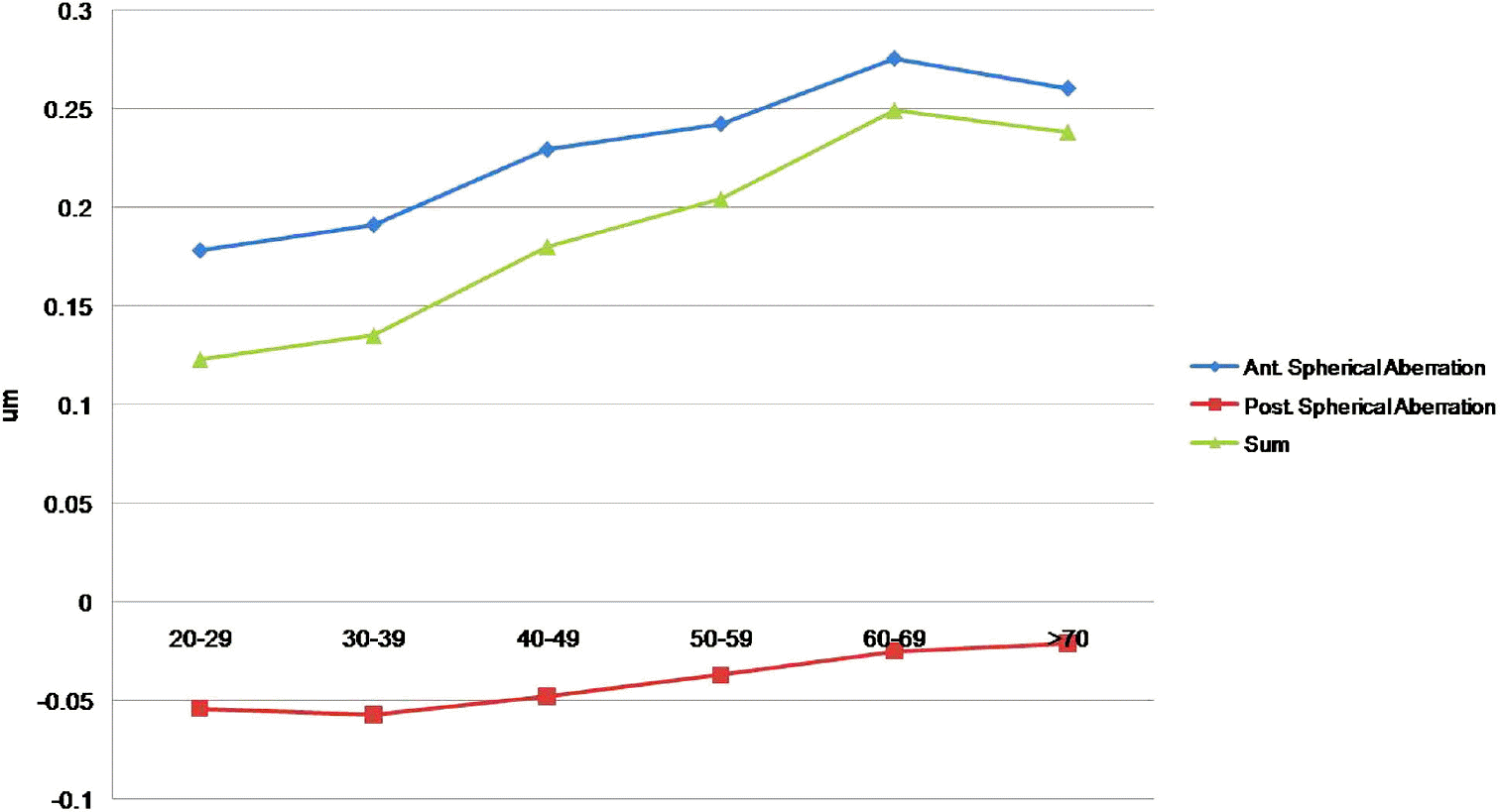Abstract
Purpose
To evaluate the spherical aberrations of the anterior and posterior surfaces of normal corneas using Pentacam in a Korean sample population and determine their ranges and changes with age.
Methods
We used Pentacam (Oculus Inc., Germany) to measure the anterior and posterior corneal spherical aberrations of 240 eyes in 240 patients with normal corneas who visited our clinic. The means and ranges of spherical aberrations and their changes with age were determined. We examined both eyes of 90 patients to confirm the inter-ocular symmetry in spherical aberration.
Results
The mean age of the 240 patients (M:F=103:137) was 49.8 years (range: 20-79), and the mean spherical aberrations of the anterior and posterior surfaces of the cornea were 0.230±0.078 μm, and -0.04±0.021 μm, respectively. The mean total corneal spherical aberration was 0.19±0.087 μm. There were no differences between males and females, and inter-ocular symmetry was observed in all tested patients. There was a tendency for the values of anterior, posterior and total corneal spherical aberration to increase with age. Ranges of spherical aberrations were from -0.177 μm to 0.423 μm in the anterior cornea, from -0.083 μm to 0.034 μm in the posterior cornea, and from -0.238 μm to 0.410 μm in the total cornea.
Conclusions
In a Korean population, the mean total corneal spherical aberration was 0.19 μm, which was shown to increase with age. Some patients were shown to have an extreme value. Based on these results, a preoperative analysis for corneal spherical aberration may be helpful when selecting aspheric intraocular lenses.
References
1. Marshall J, Cionni RJ, Davison J, et al. Clinical results of the blue-light filtering AcrySof Natural foldable acrylic intraocular lens. J Cataract Refract Surg. 2005; 31:2319–23.

2. Kim HS, Kim SW, Ha BJ, et al. Ocular aberrations and contrast sensitivity in eyes implantes with aspheric and spherical intraocular lenses. J Korean Ophthalmol Soc. 2008; 49:1256–62.
3. Wang L, Dai E, Koch DD, Nathoo A. Optical aberrations of the human cornea. J Caract Refract Surg. 2003; 29:1514–21.
4. Bellucci R, Scialdone A, Buratto L, et al. Visual acuity and contrast sensitivity comparison between Tecnis and AcrySof SA60AT intraocular lenses: A multicenter randomized study. J Cataract Refract Surg. 2005; 31:712–7.

5. Packer M, Fine IH, Hoffman RS, Piers PA. Prospective randomized trial of an anterior surface modified prolate intraocular lens. J Refract Surg. 2002; 18:692–6.

6. Rocha K, Soriano E, Chalita M, et al. Wavefront analysis and contrast sensitivity of aspheric and spherical intraocular lenses. Am J Ophthalmol. 2006; 142:750–6.
7. Tzelikis P, Akaishi L, Trindade F, Boteon J. Ocular aberrations and contrast sensitivity after cataract surgery with AcrySof IQ intraocular lens implantation. J Cataract Refract Surg. 2007; 33:1918–24.

8. Caporossi A, Martone G, Casprini F, Rapisarda L. Prospective randomized study of clinical performance of 3 aspheric and 2 spherical intraocular lenses in 250 eyes. J Refract Surg. 2007; 23:639–48.

9. Awwad ST, Lehmann JD, McCulley JP, Bowman RW. A comparison of higher order aberrations in eyes implanted with AcrySof IQ SN60WF and AcrySof SN60AT intraocular lenses. Eur J Ophthalmol. 2007; 17:320–6.

10. Dubbelman M, Sicam VADP, Van der Heijdg GL. The shape of the anterior and posterior surface of the aging human cornea. Vision Res. 2006; 46:993–1001.

11. Chen M, Yoon G. Posterior corneal aberrations and their compensation effects on anterior corneal aberrations in keratoconic eyes. Invest Ophthalmol Vis Sci. 2008; 49:5645–52.

12. Miranda MA, Radhakrishnan H, O'Donnell C. Repeatability of oculus pentacam metrics derived from corenal topography. Cornea. 2009; 28:657–66.
13. Swaartz T, Marten L, Wang M. Measuring the cornea: the latest developments in corneal topography. Curr Opin Ophthalmol. 2007; 18:325–33.
14. Mester U, Dillinger P, Anterist N. Impact of a modified optic design on visual function: clinical comparative study. J Cataract Refract Surg. 2003; 29:652–60.

15. Lim KL, Fam HB. Ethnic differences in higher-order aberrations: Spherical aberration in the South East Asian Chinese eye. J Cataract Refract Surg. 2009; 35:2144–8.

16. Amano S, Amano Y, Yamagami S, et al. Age-related changes in corneal and ocular higher-order wavefront aberrations. Am J Ophthalmol. 2004; 137:988–92.

17. Sicam VA, Dubbelman M, van der Heijde RG. Spherical aberration of the anterior and posterior surfaces of the human cornea. J Opt Soc Am A Opt Image Sci Vis. 2006; 23:544–9.

18. Guirao A, Redondo M, Artal P. Optical aberrations of the human cornea as a function of age. J Opt Soc Am A Opt Image Sci Vis. 2000; 17:1697–702.

Figure 1.
Changes in corneal spherical aberrations; anterior, posterior and total cornea (One-way ANOVA, Bonferroni test). There was a trend that all aberrations were increasing with age (40 eyes in each age group). Anterior corneal spherical aberration was not statistically significantly different between twenties and thirties, sixties and seventies but increased significantly from thirties to sixties (p<0.05). Posterior corneal spherical aberration increased significantly from forties to sixties (p<0.05). Total corneal spherical aberration increased significantly with age when compared for 20 years.

Table 1.
Spherical aberrations of anterior, posterior and whole cornea
Table 2.
Corneal spherical aberrations with age




 PDF
PDF ePub
ePub Citation
Citation Print
Print


 XML Download
XML Download